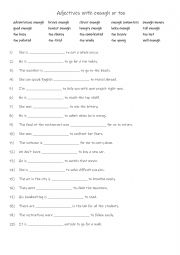
|
A2-B1 Adjectives with enough or too
Learning how to use adjectives with enough and to is important because it helps students express the right degree of a quality or characteristic. These constructions help them clearly communicate whether something meets, exceeds, or falls short of a certain standard or expectation. Answers on page 2.
Level: elementary
Age: 8-100
Type:
Downloads: 120
|
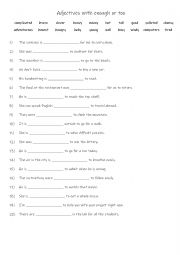
|
A2-B1 Adjectives with enough or too
Students read the sentences, then they decide what adjective with too or enough completes each sentence. Answers on page 2.
Level: intermediate
Age: 8-100
Type:
Downloads: 104
|
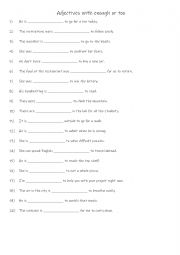
|
A2-B1 Adjectives with enough or too 3
Students read the sentences and using a suitable adjective they complete the sentences using either enough / too. Answers on page 2.
Level: intermediate
Age: 7-100
Type:
Downloads: 106
|
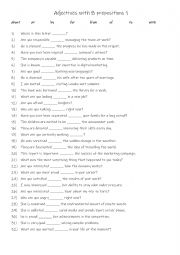
|
A2-B1 Adjectives with prepositions
Students complete the gap-fill with the correct preposition. Answers on page 2.
Level: elementary
Age: 11-100
Type: worksheet
Downloads: 110
|
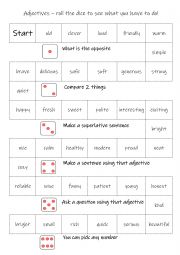
|
A2-B1 Adjectives � roll the dice to see what you have to do!
Students roll a dice or use a mobile dice app to see what they have to do with the adjective. There are 5 things they need to do; depending on the number shown when the dice is rolled. This makes the worksheet more fun and enables a more productive and engaging speaking activity.
Level: intermediate
Age: 10-100
Type:
Downloads: 120
|
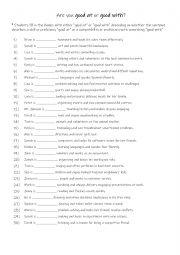
|
A2-B1 Are you good at or good with?
Students fill in the blanks with either good at or good with depending on whether the sentence describes a skill or proficiency good at or a compatibility or proficiency with something good with. Answers on page 2.
Level: intermediate
Age: 10-100
Type:
Downloads: 112
|
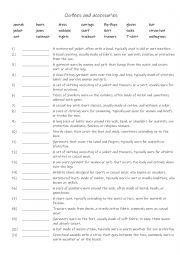
|
A2-B1 Clothes and accessories
Students match the clothes & accessories to their definition. After checking the answers, in pairs or small groups,this worksheet could also be used as a defining relative clause speaking component. Answers on page 2.
Level: elementary
Age: 10-100
Type:
Downloads: 127
|
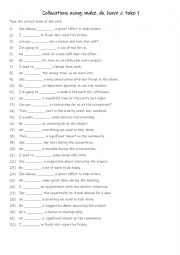
|
A2-B1 Collocations using make, do, have & take 1
Learning collocations with make, do, have, and take is important because they help you speak and write more naturally and fluently in English. These verbs often pair with specific nouns or phrases, and using them correctly improves your communication. For example, "make a decision", "do homework", "have a conversation", and "take a break" are commo...
Level: elementary
Age: 9-100
Type:
Downloads: 109
|

|
A2-B1 Collocations using make, do, have & take 2
Learning collocations with make, do, have, and take is important because they help you speak and write more naturally and fluently in English. These verbs often pair with specific nouns or phrases, and using them correctly improves your communication. For example, "make a decision", "do homework", "have a conversation", and "take a break" are commo...
Level: intermediate
Age: 8-100
Type:
Downloads: 114
|
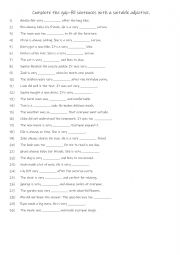
|
A2-B1 Complete the gap-fill sentences with a suitable adjective.
Students read the sentences then complete the gap-fill with a suitable adjective. This worksheet could also be used as a warmer/ cooler game where students get 1 point for a suitable adjective and 3 points if no other team has used that adjective. Possible answers on page 2.
Level: intermediate
Age: 10-100
Type:
Downloads: 132
|












